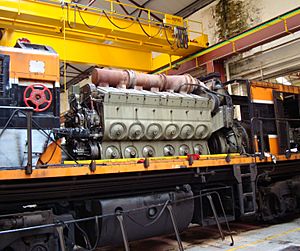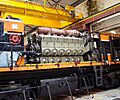Prime mover (locomotive) facts for kids
In engineering, a prime mover is a special kind of engine. It takes fuel and turns it into useful work. Think of it as the main power source.
For example, in a locomotive (a train engine), the prime mover is what makes the train move. It's the heart of the train's power. In a machine that makes electricity, like an engine-generator set, the engine is the prime mover. The generator itself is not the prime mover; it just uses the engine's power to make electricity.
Contents
What is a Prime Mover?
The prime mover is the main engine that provides power. Let's look at how it works in different types of trains:
Diesel Locomotives
- In a diesel-mechanical locomotive, the prime mover is a diesel engine. This engine is directly connected to the train's wheels. It makes the wheels turn.
- In a diesel-electric locomotive, the diesel engine is still the prime mover. But instead of directly turning the wheels, it spins a large main generator. This generator then makes electricity. The electricity powers special traction motors. These motors are connected to the wheels and make the train move.
Other Types of Prime Movers
Sometimes, a gas turbine can be used as a prime mover instead of a diesel engine. It works in a similar way, creating power from fuel.
The generator, the traction motors, and all the parts that connect them are called the power transmission system. They help move the power, but they are not the prime mover itself.
Trains Without Onboard Prime Movers
Some trains do not have a prime mover on board. For example, a wired-electric train gets its power from overhead lines or a third rail. A battery-electric train gets its power from large batteries. These trains rely on an outside power station for their energy.
The Power Unit

In a diesel-electric train, the engine (the prime mover) and the generator are often put together. They form a single, removable part called "the power unit." This makes it easier to build and repair the train.
Weight and Design
The power unit is usually the heaviest part of a train, besides the main frame. Train designers carefully choose where to place this heavy unit. Its position helps balance the train's weight.
Most of the time, the power unit is placed in the middle of the train. But sometimes, it might be moved to one end. This can happen if the engine is heavier than the generator. In some special designs, like those with C-B wheel arrangements, the weight on each set of wheels might be very different. To make sure each wheel carries a similar load, the end with the engine might get an extra wheel set. This helps keep the train stable and safe.
Images for kids
See also
 In Spanish: Motor principal (locomotora) para niños
In Spanish: Motor principal (locomotora) para niños




